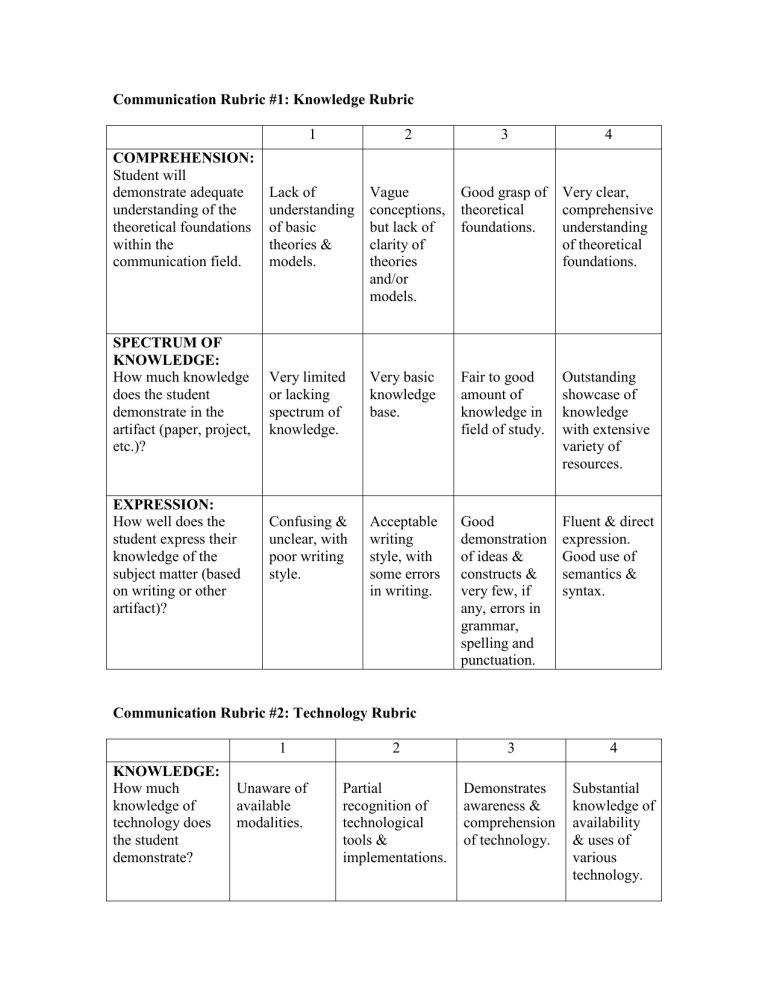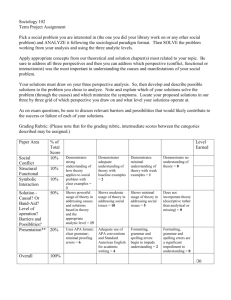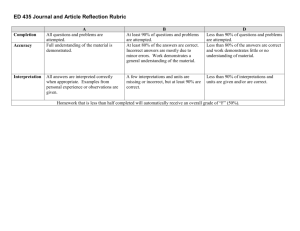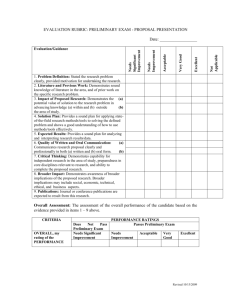Communication Rubric #1: Knowledge Rubric

Communication Rubric #1: Knowledge Rubric
1 2
COMPREHENSION:
Student will demonstrate adequate understanding of the theoretical foundations within the communication field.
Lack of understanding of basic theories & models.
Vague conceptions, but lack of clarity of theories and/or models.
3
Good grasp of theoretical foundations.
4
Very clear, comprehensive understanding of theoretical foundations.
SPECTRUM OF
KNOWLEDGE:
How much knowledge does the student demonstrate in the artifact (paper, project, etc.)?
Very limited or lacking spectrum of knowledge.
Very basic knowledge base.
Fair to good amount of knowledge in field of study.
Outstanding showcase of knowledge with extensive variety of resources.
EXPRESSION:
How well does the student express their knowledge of the subject matter (based on writing or other artifact)?
Confusing & unclear, with poor writing style.
Acceptable writing style, with some errors in writing.
Good demonstration of ideas & constructs & very few, if any, errors in grammar, spelling and punctuation.
Communication Rubric #2: Technology Rubric
1 2
KNOWLEDGE:
How much knowledge of technology does the student demonstrate?
Unaware of available modalities.
Partial recognition of technological tools & implementations.
3
Demonstrates awareness & comprehension of technology.
Fluent & direct expression.
Good use of semantics & syntax.
4
Substantial knowledge of availability
& uses of various technology.
APTITUDE &
ATTITUDE:
What is the aptitude & attitude of the student as demonstrated in project, paper or other artifact?
EXPRESSION:
How is the student’s view expressed as a product of the artifact that is assessed?
Total indifference or even a negative attitude toward technology.
Indifferent attitude toward knowledge of technology.
Poor to lacking ability to demonstrate knowledge or understanding.
Minimal demonstration of understanding & knowledge.
Fairly appreciable of using technology & gaining knowledge of uses.
Satisfactory expression of knowledge.
Appreciation for and positive thinking toward knowledge & uses of technology.
Exemplary display of technology related materials.
Communication Rubric #3: Research & Inquiry Rubric
1 2 3 4
KNOWLEDGE
&
ACQUISITION:
What knowledge was acquired in the project, paper or artifact?
Deficiency or lack of knowledge in the field of study.
Borderline knowledge through research & inquiry.
Sufficiency in demonstrating knowledge in field of study.
Proficient in demonstrating knowledge.
APPROACH TO
LEARNING:
What is the student’s general attitude as assessed from direct answers to questions from artifact?
Does not value the learning process or believe in its utility.
Demonstrates some value, but with neutral appreciation of knowledge.
Good appreciation of knowledge and usability.
Extreme enthusiasm & appreciation of knowledge acquisition.
RESOURCES:
What type & amount of resources were used? Are the sources cited?
What is the
No resources cited.
Few resources used, but lacking sufficiency.
Acceptable resources in number, variety
& frequency.
Evidence of excellent demonstration of materials, resources & inquiry methods. frequency of use?
Communication Rubric #4: Written Communication Rubric (same as gen. ed. communication rubric)
1 2 3
ORGANIZATION:
How do the components of the piece fit together?
How do ideas in developing paragraphs & sentences flow?
STYLE:
Considers word choice, appropriateness of vocabulary, variety in sentence and paragraph structure, conciseness and level of formality.
CORRECTNESS:
Includes grammar, usage, capitalization, punctuation, spelling
Intro. is weak or unclear; organizational patterns show little or no relation to purpose. Writing is confusing & incoherent & conclusion is weak.
Writing demonstrates little or no variety in word choice & sentence/paragraph structure. Many lapses in clarity and conciseness.
Level or formality is inappropriate to purpose.
Writing demonstrates consistent incorrect grammar
Intro. is present, but undeveloped.
Organization suited to purpose
& main idea.
Writing makes some sense of the time, but still lapses in coherence.
Writing demonstrates some variety in word choice and sentence/paragraph structure. Writing communicates, but some lapses in clarity & conciseness. Level of formality somewhat appropriate.
Writing demonstrates some grammar & usage flaws. Piece
Intro. is inviting & organizational patterns work.
Writing generally makes sense; rare lapses in coherence.
Writing often demonstrates variety in word choice and sentence/paragraph structure. Writing is clear, concise & level of formality is appropriate.
Writing demonstrates general correctness of grammar &
Intro. is strong along with organization patterns. Writing is consistently coherent.
Writing
4 consistently demonstrates variety in word choice and sentence/paragraph structure. Writing clear, concise & level of formality well suited to purpose.
Writing demonstrates mastery of grammar & usage.
& proofreading. & usage. Piece does not adhere to writing conventions. adheres to writing conventions sometimes. usage. Piece generally adheres to writing conventions.
Piece consistently adheres to writing conventions.
Communication Rubric #5: Ethics & Social Responsibility Rubric
1 2 3 4
UNDERSTANDING
OF ETHICS &
SOCIAL
RESPONSIBILITY:
What is the student’s abstract understanding of ethics & social responsibility as related to the communication field?
INTENTIONS OF
USE:
What is the student’s intention of use as declared in answers to questions in the artifact(s)?
No understanding of the rules of ethical behavior as demanded in journalism, public relations, advertising or other communicationrelated area.
Disregard of ethical rules & standards as applied to field of communication.
SPIRITUAL
VALUES &
ETHICS:
Does the student realize the relationship between spiritual values & communication ethics?
Partial understanding
& comprehension of ethical rules
& their dimensions.
Doubtful or uncertain of validity of intentions.
Shows little or no understanding of connection between foundational beliefs & values
& life
Shows some ability to recognize the connection between spiritual values
& communication
Demonstrates knowledge of ethical rules & social responsibility.
Limited scope of applicability of ethical rules or relevance for intentions of use.
Shows ability to make clear, well thought out connections between beliefs
& communication ethics.
Substantial knowledge & understanding of rules in the field of communication.
Declared intentions are clearly in line
& consistent with standards
& codes of ethics in communication.
Shows exceptional ability to explore the relationship between spiritual values
&
decisions.
Doesn’t see how one’s choices affect the person one becomes as well as the wider world. ethics. Also recognizes the ethical implications of personal decisions related to social
& global issues in communication. communication ethics. Has a firm grasp on how their spiritual values impact their ethical decisions in communication.






